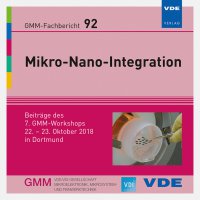Penetrating nanoelectrodes for an electrical cell interface on CMOS ASIC
Konferenz: Mikro-Nano-Integration - 7. GMM-Workshop
22.10.2018 - 23.10.2018 in Dortmund, Deutschland
Tagungsband: Mikro-Nano-Integration
Seiten: 6Sprache: EnglischTyp: PDF
Persönliche VDE-Mitglieder erhalten auf diesen Artikel 10% Rabatt
Autoren:
Allani, S.; Jupe, A.; Utz, A.; Schaal, C.; Kappert, H. (Fraunhofer Institute for Microelectronic Circuits and Systems IMS, Duisburg, Germany)
Rustom, A. (University of Heidelberg, Department of Neuroscience, Heidelberg, Germany)
Vogt, H. (Fraunhofer Institute for Microelectronic Circuits and Systems IMS, Duisburg, Germany & University Duisburg Essen, Electronic Components and Circuits, Duisburg, Germany)
Inhalt:
Understanding the intercellular communication processes and applying the knowledge on technical devices is crucial for various biomedical applications like implants or intelligent sensors. Microelectrode arrays (MEA) can detect and stimulate electrical signals of biological cells. The combination of MEA and CMOS integrated circuits results in a device with high integration density and sensitivity. Most of the known CMOS MEA are based on planar electrodes and measure the cell signals capacitively. Vertical nanoelectrodes can penetrate the cell membrane so that intracellular signals are measured directly. Here we present the concepts of fabricating three-dimensional electrodes. First cell incubations indicate, that they can penetrate the cell membrane due to a tapered diameter and a pointed tip. The design of a multifunctional CMOS integrated circuit for stimulation and recording of electrical bio-signals is set out in the following.


